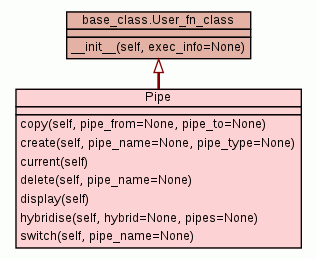
| Trees | Indices | Help |
|
|---|
|
|

Class for holding the functions for manipulating data pipes.
|
|||
|
|||
|
|||
|
|||
|
|||
|
|||
|
|||
|
|||
|
Inherited from |
|||
|
|||
Copy a data pipe.
Keyword Arguments
~~~~~~~~~~~~~~~~~
pipe_from: The name of the source data pipe to copy the data from.
pipe_to: The name of the target data pipe to copy the data to.
Description
~~~~~~~~~~~
This allows the contents of a data pipe to be copied. If the source data pipe is not set, the
current data pipe will be assumed. The target data pipe must not yet exist.
Examples
~~~~~~~~
To copy the contents of the 'm1' data pipe to the 'm2' data pipe, type:
relax> pipe.copy('m1', 'm2')
relax> pipe.copy(pipe_from='m1', pipe_to='m2')
If the current data pipe is 'm1', then the following command can be used:
relax> pipe.copy(pipe_to='m2')
|
Add a new data pipe to the relax data store.
Keyword Arguments
~~~~~~~~~~~~~~~~~
pipe_name: The name of the data pipe.
pipe_type: The type of data pipe.
Description
~~~~~~~~~~~
The data pipe name can be any string however the data pipe type can only be one of the following:
'ct': Consistency testing,
'frame order': The Frame Order theories,
'jw': Reduced spectral density mapping,
'hybrid': A special hybrid pipe,
'mf': Model-free analysis,
'N-state': N-state model of domain motions,
'noe': Steady state NOE calculation,
'relax_fit': Relaxation curve fitting,
Examples
~~~~~~~~
To set up a model-free analysis data pipe with the name 'm5', type:
relax> pipe.create('m5', 'mf')
|
Print the name of the current data pipe. Examples ~~~~~~~~ To run the user function, type: relax> pipe.current() |
Delete a data pipe from the relax data store. Keyword Arguments ~~~~~~~~~~~~~~~~~ pipe_name: The name of the data pipe to delete. Description ~~~~~~~~~~~ This will permanently remove the data pipe and all of its contents from the relax data store. If the pipe name is not given, then all data pipes will be deleted. |
Print a list of all the data pipes. Examples ~~~~~~~~ To run the user function, type: relax> pipe.display() |
Create a hybrid data pipe by fusing a number of other data pipes.
Keyword Arguments
~~~~~~~~~~~~~~~~~
hybrid: The name of the hybrid data pipe to create.
pipes: An array containing the names of all data pipes to hybridise.
Description
~~~~~~~~~~~
This user function can be used to construct hybrid models. An example of the use of a hybrid model
could be if the protein consists of two independent domains. These two domains could be analysed
separately, each having their own optimised diffusion tensors. The N-terminal domain data pipe
could be called 'N_sphere' while the C-terminal domain could be called 'C_ellipsoid'. These two
data pipes could then be hybridised into a single data pipe. This hybrid data pipe can then be
compared via model selection to a data pipe whereby the entire protein is assumed to have a single
diffusion tensor.
The requirements for data pipes to be hybridised is that the molecules, sequences, and spin systems
for all the data pipes is the same, and that no spin system is allowed to be selected in two or more
data pipes. The selections must not overlap to allow for rigorous statistical comparisons.
Examples
~~~~~~~~
The two data pipes 'N_sphere' and 'C_ellipsoid' could be hybridised into a single data pipe
called 'mixed model' by typing:
relax> pipe.hybridise('mixed model', ['N_sphere', 'C_ellipsoid'])
relax> pipe.hybridise(hybrid='mixed model', pipes=['N_sphere', 'C_ellipsoid'])
|
Switch between the data pipes of the relax data store.
Keyword Arguments
~~~~~~~~~~~~~~~~~
pipe_name: The name of the data pipe.
Description
~~~~~~~~~~~
This will switch between the various data pipes within the relax data store.
Examples
~~~~~~~~
To switch to the 'ellipsoid' data pipe, type:
relax> pipe.switch('ellipsoid')
relax> pipe.switch(pipe_name='ellipsoid')
|
| Trees | Indices | Help |
|
|---|
| Generated by Epydoc 3.0.1 on Wed Apr 10 13:31:52 2013 | http://epydoc.sourceforge.net |